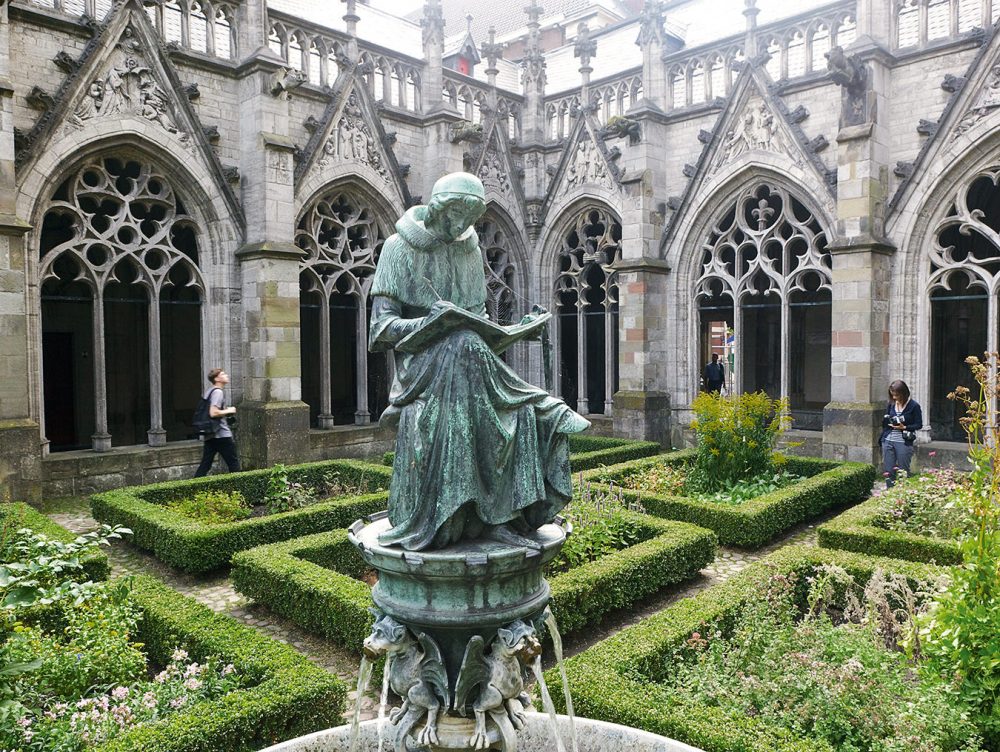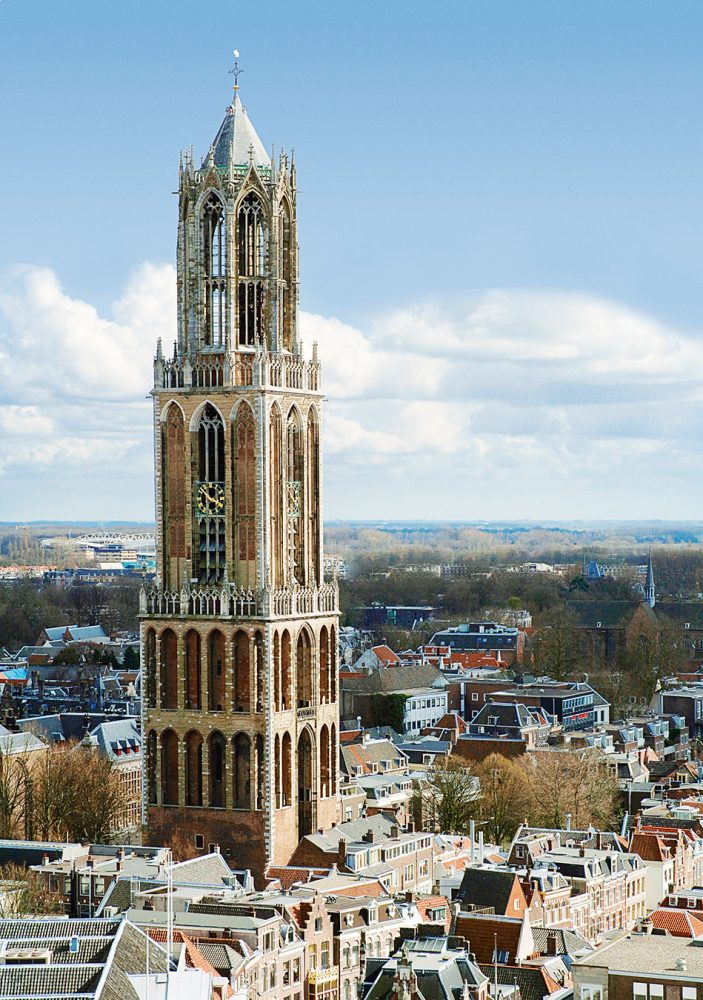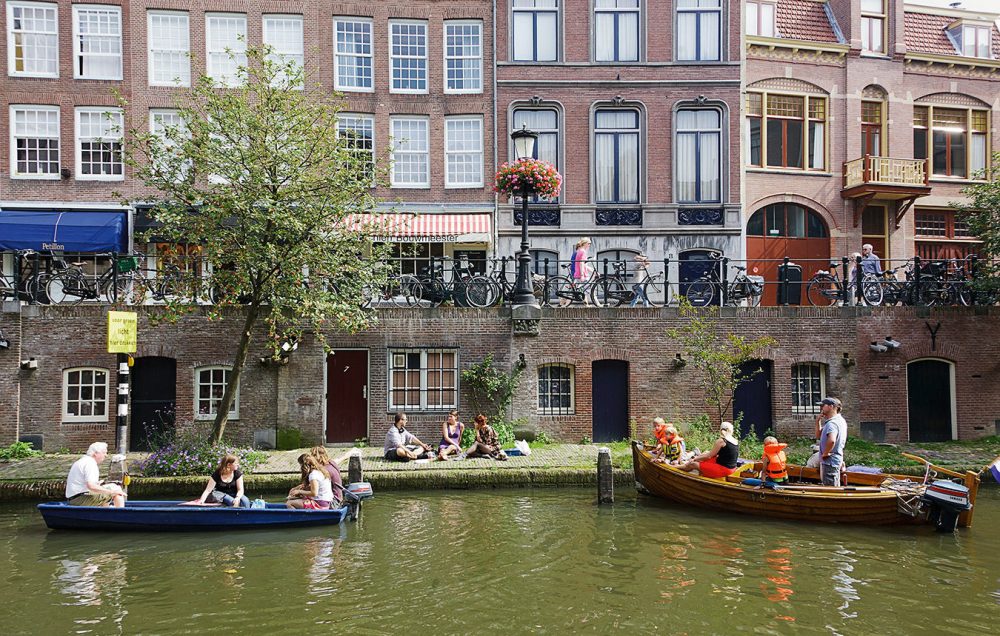Up until the Dutch Golden Age, Utrecht functioned as the heart of the Netherlands, a pivotal religious centre and an integral railway hub. Utrecht’s history is long, spanning nearly two millennia. The city itself began in 47 AD as a Roman fortification with a neighbouring settlement of artisans and traders. Today, it is known primarily as a university town, with one of the leading faculties of science in Europe; it wasn’t always this way—for a short while in the mid-17th century, tax breaks on beer and wine were offered to attract students. Needless to say, that was abolished before long.
This year, strings of small multicoloured flags have been strung in rows across streets to celebrate the tercentenary of the Treaty of Utrecht, which ended two centuries of conflict and religious wars in Europe. These brightly painted crests contribute to the city’s medieval vista and festive atmosphere, along with the bells that toll every quarter from the Dom Tower. Two canals—the Oudegracht and the Nieuwegracht—run the length of the city, which is still mostly encircled by the original moat. Unique to Utrecht, wharves were built in the 13th century along the Oudegracht to facilitate trade; today, the terraces function as popular patios for cafés and restaurants housed in the old cellars.
At just over 112 metres in height, the Dom Tower is the tallest church tower in the Netherlands and an essential part of the city’s landscape. It’s a beacon for travellers, and for locals returning from a trip big or small, it’s a comforting sight—a sign that they’ve arrived home. Building began in 1321 and took 61 years to complete. It was originally a part of the Cathedral of Saint Martin, but the nave collapsed in 1674 and the Gothic tower became free-standing. Climbing the tower is a must—for the history, yes, but above all, for the view. On a clear day, it’s possible to see Amsterdam and Rotterdam. (Strangely enough, the Dom Tower has been replicated at Huis Ten Bosch, a theme park in Nagasaki, Japan. The imitation has a lift, however, and Japanese tourists are often bewildered when they arrive in Utrecht to find that they have no choice but to take the stairs, all 465 of them.)
The northern part of town has been a site of change stemming from the train station and the Hoog Catharijne mall now attached to it. The southern half of the city, known as the Museumkwartier, is quieter, better preserved, and touted as an open-air museum. Here is where it’s actually possible to stumble into a page from a fairy tale; you may wander into secret brick-lined alleyways concealed by a canopy of vines and peaceful hidden courtyards.
The Museumkwatier is also where you’ll find godskameren, or almshouses, which were charitable rent-free complexes built by wealthy Catholics and Protestants between the 16th and 19th centuries to house the poor. Many of these have now been converted into apartments. There is also a high concentration of churches in Utrecht, owing to its history as home to important religious seats of power. Many still remain, but one in particular has found a new function: St. Martin’s church has now been creatively converted into apartments.
Utrecht is a beautiful city and a delightful place to wander. It’s quiet, yet lively; in place of traffic you’ll hear the sound of bicycle tires bouncing over brick, bells chiming.
The Railway Museum boasts an impressive collection of steam, electric, and diesel locomotives; rolling stock; armoured vehicles; and railway paraphernalia. The collection—housed in the restored 1874 Maliebaan station—is spread across an impressive area of 40,000 square metres, and it is entirely possible to spend all day meandering about. The bustle inside and out adds to the charm and makes the railway station come alive. Although the children of our current generation may be looking up toward the stars and envisioning themselves in spaceships, kids zipping excitedly from shunter to tank to steam engine shrieking in delight indicates that these steel beasts continue to fascinate.
There are other engaging museums to visit in Utrecht, such as the Dick Bruna Huis, home to Miffy the bunny, and the Sonnenborgh Museum and Observatory, housed in a 16th century bastion and outfitted with four telescopes. But there’s another little treasure in Utrecht tucked away in the heart of the old town, in a courtyard between Het Hoogt and Lange Jaanstraat: the Grocer’s Museum. It’s a small, old-fashioned grocery that was founded in 1873 by Betje Boerhave. Glass jars filled with confections line the shelves, and there’s lots and lots of licorice. A selection of nostalgic Dutch sweets—including ulevellen (flavoured sugar candies) and polkabrokken (caramel sweets)—can be found alongside fresh mustard, gingerbread, and peppermint. Upstairs, there is a small museum with sundry curiosities and various household goods.
By night, Utrecht can become a pretty sleepy place (depending on whether school is in session) and the beautiful architectural details visible by day are obscured in shadow. So in 2010, a delightful art route was launched to encourage both locals and travellers to experience the city in a different light. Trajectum Lumen consists of 15 installations around the city that turn on at sundown and shut off at about midnight. A light surface on the Bezembrug bridge is slowly swept away, indicating the site of a broom market in ancient times; a neon halo floats around the crest of Sint Willibrordkerk chapel, pointing the way to one of the city’s best-kept secrets. The Neudeflat was built in the sixties and is commonly thought of as one of the ugliest buildings in the city; locals decry it as anonymous and dull. A team of students from the Utrecht School of the Arts filmed the eyes of employees in the building as they made different facial expressions; this is now projected on the windows at the Neudeflat, giving the building a face and a soul.
Stay a little while and make one of the cozy spots in the city, such as the B&B Gregorius, your home base, or opt for a more grandiose experience at the Karel V, the former headquarters of the Knights of the Teutonic Order. Utrecht is a beautiful city and a delightful place to wander. It’s quiet, yet lively; in place of traffic you’ll hear the sound of bicycle tires bouncing over brick, bells chiming. But look up (or you might miss the Utrecht UFO, a flying saucer perched on the current ProRail building), look down (a Trajectum Lumen artwork marks the former castellum wall around the city), look around you. Utrecht is a city for exploring.
All photos courtesy of Toerisme Utrecht.











